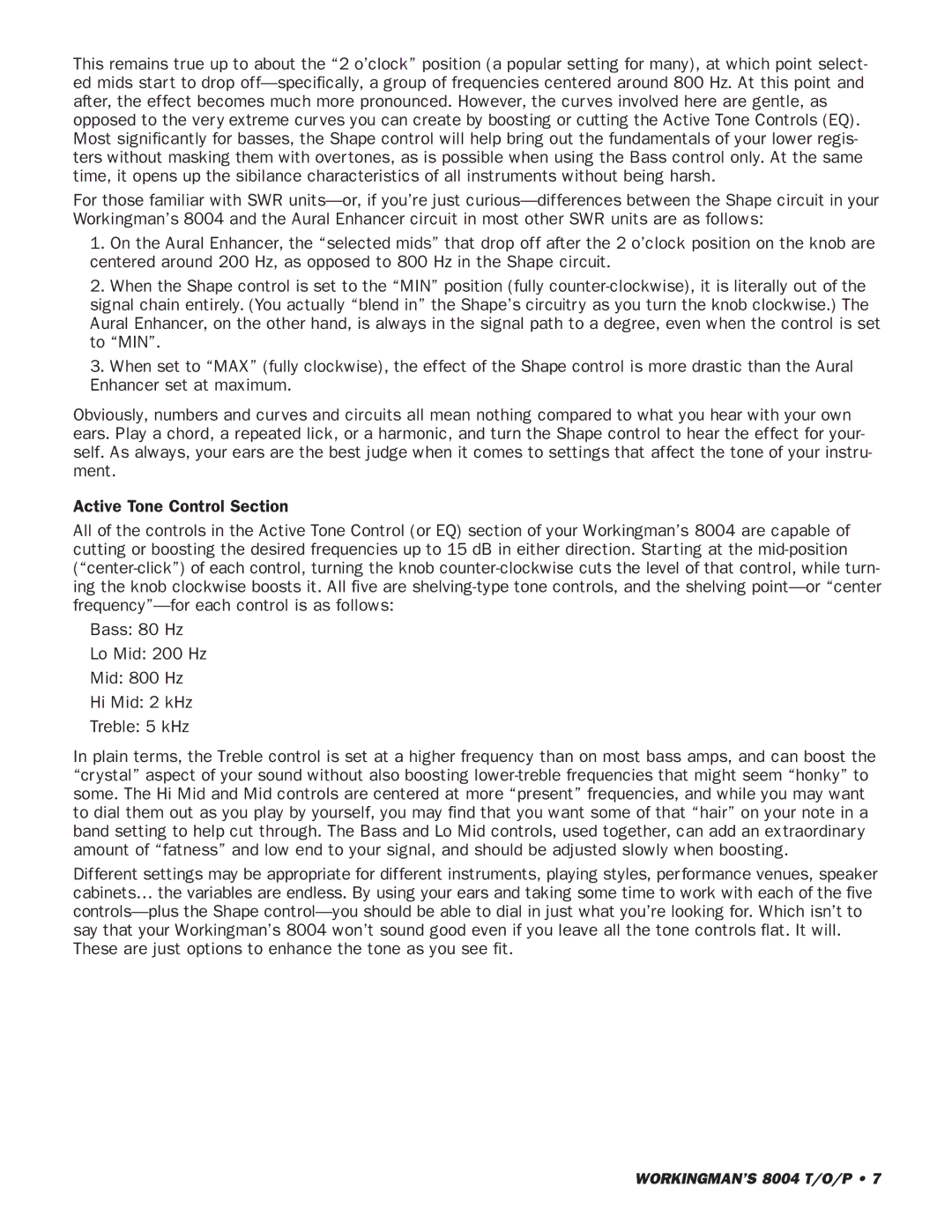This remains true up to about the “2 o’clock” position (a popular setting for many), at which point select- ed mids start to drop off—specifically, a group of frequencies centered around 800 Hz. At this point and after, the effect becomes much more pronounced. However, the curves involved here are gentle, as opposed to the very extreme curves you can create by boosting or cutting the Active Tone Controls (EQ). Most significantly for basses, the Shape control will help bring out the fundamentals of your lower regis- ters without masking them with overtones, as is possible when using the Bass control only. At the same time, it opens up the sibilance characteristics of all instruments without being harsh.
For those familiar with SWR units—or, if you’re just curious—differences between the Shape circuit in your Workingman’s 8004 and the Aural Enhancer circuit in most other SWR units are as follows:
1.On the Aural Enhancer, the “selected mids” that drop off after the 2 o’clock position on the knob are centered around 200 Hz, as opposed to 800 Hz in the Shape circuit.
2.When the Shape control is set to the “MIN” position (fully counter-clockwise), it is literally out of the signal chain entirely. (You actually “blend in” the Shape’s circuitry as you turn the knob clockwise.) The Aural Enhancer, on the other hand, is always in the signal path to a degree, even when the control is set to “MIN”.
3.When set to “MAX” (fully clockwise), the effect of the Shape control is more drastic than the Aural Enhancer set at maximum.
Obviously, numbers and curves and circuits all mean nothing compared to what you hear with your own ears. Play a chord, a repeated lick, or a harmonic, and turn the Shape control to hear the effect for your- self. As always, your ears are the best judge when it comes to settings that affect the tone of your instru- ment.
Active Tone Control Section
All of the controls in the Active Tone Control (or EQ) section of your Workingman’s 8004 are capable of cutting or boosting the desired frequencies up to 15 dB in either direction. Starting at the mid-position (“center-click”) of each control, turning the knob counter-clockwise cuts the level of that control, while turn- ing the knob clockwise boosts it. All five are shelving-type tone controls, and the shelving point—or “center frequency”—for each control is as follows:
Bass: 80 Hz
Lo Mid: 200 Hz
Mid: 800 Hz
Hi Mid: 2 kHz
Treble: 5 kHz
In plain terms, the Treble control is set at a higher frequency than on most bass amps, and can boost the “crystal” aspect of your sound without also boosting lower-treble frequencies that might seem “honky” to some. The Hi Mid and Mid controls are centered at more “present” frequencies, and while you may want to dial them out as you play by yourself, you may find that you want some of that “hair” on your note in a band setting to help cut through. The Bass and Lo Mid controls, used together, can add an extraordinary amount of “fatness” and low end to your signal, and should be adjusted slowly when boosting.
Different settings may be appropriate for different instruments, playing styles, performance venues, speaker cabinets… the variables are endless. By using your ears and taking some time to work with each of the five controls—plus the Shape control—you should be able to dial in just what you’re looking for. Which isn’t to say that your Workingman’s 8004 won’t sound good even if you leave all the tone controls flat. It will. These are just options to enhance the tone as you see fit.
